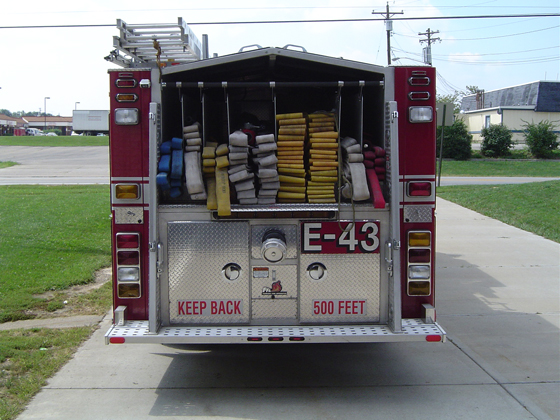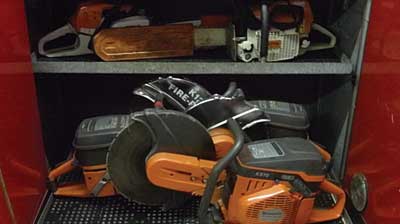
 |
| Click here to view the image gallery. |
By Mark Miller
Conducting a thorough apparatus needs analysis is the essential first step to ensure the apparatus being purchased will fit the community it will protect. Departments must take several community-specific considerations into account to ensure the apparatus will be operationally effective not only for the short term but for its entire service life. This needs analysis will further serve as the basis to justify the expenditure to a municipality’s elected and appointed officials during the procurement process. Although many communities appear to be similar, each has its own specific intricacies that require a detailed analysis prior to beginning the specification process.
What Is It?
An apparatus needs analysis is the process used to identify and evaluate needs that are specific to a community that the apparatus protects. Many departments aren’t afforded the opportunity to regularly replace fire apparatus. Therefore, it is essential that departments use a systematic process of identifying a community’s specific needs. By conducting an apparatus needs analysis, they can ensure they purchase apparatus based on their community-specific needs and not personal wants. This process has been successfully used on all types of units including advanced life support (ALS) transport vehicles, tenders, pumpers, aerials, and heavy rescues.
Community-specific needs include a community’s setting, such as urban, suburban, and rural, or any combination of the three. The community’s geography, topography, population density, development densities, and previous incident data are also factors to include. Furthermore, consider the forecasted use of undeveloped land. Although zoning restrictions are subject to change, zoning commissions usually have an idea of how much latitude they are willing to give developers. Last, take municipal water supply considerations into account. Each of these specific needs comes with its own inherent challenges for a fire department to overcome to ensure its constituency gets a piece of apparatus that can safely, efficiently, and effectively mitigate incidents.
Community-specific needs will help departments determine maximum height, weight, overall length, wheelbase, cramp angle, and angle of approach and departure requirements. Topography can aid in specifying engine torque, braking system requirements, and outrigger penetration requirements. Population density will aid departments in forecasting expected call volume and traffic congestion. Development density aids in determining hoseline types and lengths and portable and aerial ladder requirements. Development setbacks also vary widely among communities and must be taken into account. Data collected from previous incidents can identify the types and quantity of calls a unit will most likely respond to during its tenure. This data can also help crews recall what has worked with a current unit and what could make their service delivery easier in the street. Last, municipal water supply considerations will help determine the amount of water a unit must carry. This will also aid in the amount of water needed on auxiliary units such as tankers/tenders.
Fire Department
The fire department’s capabilities are also an important component of an apparatus needs analysis. Staffing, station distribution, and mutual-aid availability are extremely important to determine the type of apparatus a department needs to purchase. Staffing can comprise volunteer, paid on-call, and career personnel. Departments must be realistic with their apparatus staffing numbers during this process, as most organizations only respond with three- to four-person crews.
Station distribution can help by determining how long the unit is projected to operate at an emergency incident prior to another fire company arriving. Last, the mutual- or automatic-aid availability is important to reduce equipment redundancy in a specific geographic region.
Specifics regarding the services a fire department offers to its community also play a significant role in the needs analysis. The equipment a fire company carries is often more important than the unit itself. Conducting the needs analysis will help determine what equipment apparatus must carry to protect a community. No one unit can carry all the equipment needed to mitigate each hazard.
Multipurpose apparatus can accomplish several initial tasks but usually lack the equipment to accomplish any single task well. Emergency medical services, whether first response or full ALS, will significantly increase the calls for service to which the unit will respond and the equipment it must carry. Technical rescue and traditional special service equipment can easily take up valuable real estate within compartments and add a considerable amount of weight.
Pumpers
Engine companies are the backbone of the American fire service. We have to ensure that the engine company can safely, efficiently, and effectively operate at structural fires. The engine company must operate at a wide array of occupancy types with varying setbacks. This requires the ability to establish a water supply via a forward lay, reverse lay, or drop tank; the ability to stretch lines that are long enough and large enough to at least hold a fire until more help arrives; and the ability to rapidly deploy truck and portable master streams to achieve flow rates in excess of 1,000 gallons per minute. Each community is different, so engine hose loads should be too. There isn’t a one-size-fits-all hose load or length in the fire service. Conducting a thorough needs analysis will help identify the appropriate size, length, and quantity of hoselines to carry on engines.
Ladder Trucks
Aerial apparatus come in several different types with various mounting and outrigger configurations. Each type has advantages and disadvantages. It is imperative that departments take their time to ensure the type of aerial purchased will not only fit through their communities but be able to carry the portable ladders and equipment necessary to make their crews more efficient and effective. The type of aerial to purchase is an ongoing debate in the fire service. However, it must be based on common occupancy types, the amount of equipment and portable ladders the department needs to carry, as well as if there is a need for quint capabilities.
The length and type of aerial purchased is directly related to the findings of the apparatus needs analysis. Communities with little to no setbacks may benefit from aerials with shorter bedded lengths to facilitate rotation at lower angles. Communities with larger setbacks and taller structures will benefit from 100-foot or greater devices. Departments that respond mainly to incidents in single-family dwellings most likely won’t need to spend the additional capital on a larger, more expensive tower ladder. Outrigger configurations, penetration, and quantities are other points of concern for the needs analysis. Development densities may make it difficult to set up large aerial devices without a short jack option.
Spend Time Up Front
By taking the time to conduct a thorough apparatus needs analysis up front, departments can ensure the apparatus they specify will be effective not only for the short term but for the entire service life of the units. Although this article has identified several community-specific considerations, this isn’t an exhaustive list by any means. No matter what apparatus type you purchase, if it is intended to be the initial responding unit to structural fires, it must be able to get lines to the fire in each type of occupancy in your first-due response area. This can easily be overlooked as multipurpose apparatus are becoming the norm because of financial and staffing constraints.
MARK MILLER is a battalion chief in the Warren County (OH) Fire Department. He is a 20-year veteran of the fire service and has worked for multiple organizations in the Cincinnati metro region. He has a bachelor’s degree from the University of Cincinnati and a master’s degree from Lewis University in fire science and administration. He teaches throughout the state and has been involved with the fire apparatus procurement process for the past 12 years.

